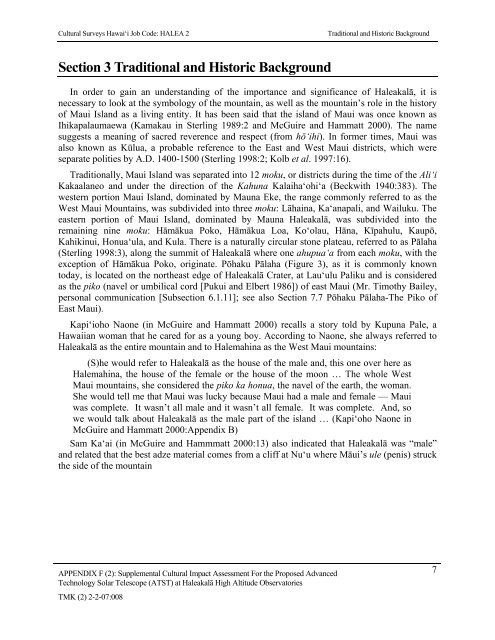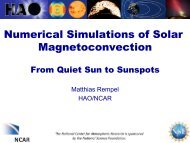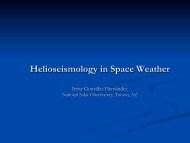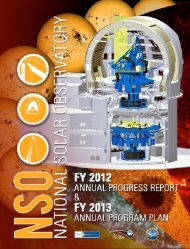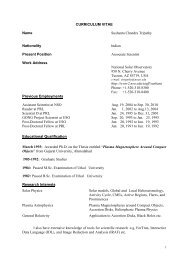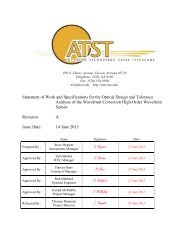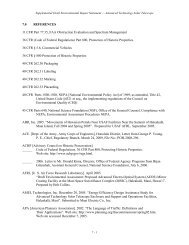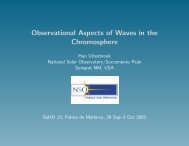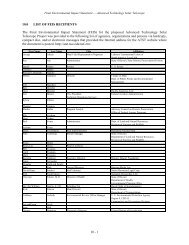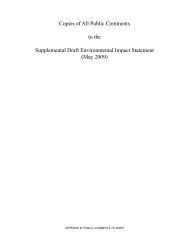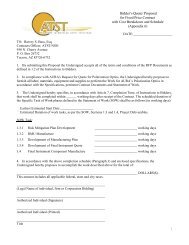F2 - ATST
F2 - ATST
F2 - ATST
Create successful ePaper yourself
Turn your PDF publications into a flip-book with our unique Google optimized e-Paper software.
Cultural Surveys Hawai‘i Job Code: HALEA 2Traditional and Historic BackgroundSection 3 Traditional and Historic BackgroundIn order to gain an understanding of the importance and significance of Haleakalā, it isnecessary to look at the symbology of the mountain, as well as the mountain’s role in the historyof Maui Island as a living entity. It has been said that the island of Maui was once known asIhikapalaumaewa (Kamakau in Sterling 1989:2 and McGuire and Hammatt 2000). The namesuggests a meaning of sacred reverence and respect (from hō‘ihi). In former times, Maui wasalso known as Kūlua, a probable reference to the East and West Maui districts, which wereseparate polities by A.D. 1400-1500 (Sterling 1998:2; Kolb et al. 1997:16).Traditionally, Maui Island was separated into 12 moku, or districts during the time of the Ali‘iKakaalaneo and under the direction of the Kahuna Kalaiha‘ohi‘a (Beckwith 1940:383). Thewestern portion Maui Island, dominated by Mauna Eke, the range commonly referred to as theWest Maui Mountains, was subdivided into three moku: Lāhaina, Ka‘anapali, and Wailuku. Theeastern portion of Maui Island, dominated by Mauna Haleakalā, was subdivided into theremaining nine moku: Hāmākua Poko, Hāmākua Loa, Ko‘olau, Hāna, Kīpahulu, Kaupō,Kahikinui, Honua‘ula, and Kula. There is a naturally circular stone plateau, referred to as Pālaha(Sterling 1998:3), along the summit of Haleakalā where one ahupua‘a from each moku, with theexception of Hāmākua Poko, originate. Pōhaku Pālaha (Figure 3), as it is commonly knowntoday, is located on the northeast edge of Haleakalā Crater, at Lau‘ulu Paliku and is consideredas the piko (navel or umbilical cord [Pukui and Elbert 1986]) of east Maui (Mr. Timothy Bailey,personal communication [Subsection 6.1.11]; see also Section 7.7 Pōhaku Pālaha-The Piko ofEast Maui).Kapi‘ioho Naone (in McGuire and Hammatt 2000) recalls a story told by Kupuna Pale, aHawaiian woman that he cared for as a young boy. According to Naone, she always referred toHaleakalā as the entire mountain and to Halemahina as the West Maui mountains:(S)he would refer to Haleakalā as the house of the male and, this one over here asHalemahina, the house of the female or the house of the moon … The whole WestMaui mountains, she considered the piko ka honua, the navel of the earth, the woman.She would tell me that Maui was lucky because Maui had a male and female — Mauiwas complete. It wasn’t all male and it wasn’t all female. It was complete. And, sowe would talk about Haleakalā as the male part of the island … (Kapi‘oho Naone inMcGuire and Hammatt 2000:Appendix B)Sam Ka‘ai (in McGuire and Hammmatt 2000:13) also indicated that Haleakalā was “male”and related that the best adze material comes from a cliff at Nu‘u where Māui’s ule (penis) struckthe side of the mountainAPPENDIX F (2): Supplemental Cultural Impact Assessment For the Proposed AdvancedTechnology Solar Telescope (<strong>ATST</strong>) at Haleakalā High Altitude ObservatoriesTMK (2) 2-2-07:0087


